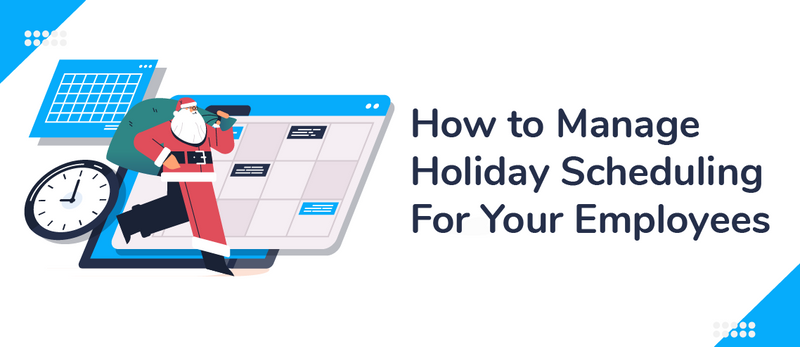How to Manage Holiday Scheduling for Your Employees

When we think of the holidays, the last thing anyone pictures is being sat at work. Holiday scheduling can be a headache for business owners, as most employees want to take PTO to spend with their families over the holidays.
Those in the retail and service industries, for example, may be called upon to work even more during the busy holiday season, leaving managers equally as busy making sure that every holiday shift is covered. This is easier said than done, but putting a game plan for managing schedules can help prevent headaches down the road.
So, how do you deal with holiday scheduling and avoid disappointment and chaos?
1. Set Deadlines for PTO Requests
Your business can’t function without some level of certainty. You need to be able to plan ahead, which means there has to be a deadline for PTO requests.
It’s perfectly acceptable that many of your employees will be spending the holidays with family and friends, but they should know what is expected of them at work in order to properly balance the two this holiday season.
To give your business the certainty it needs while allowing your employees to enjoy time off during the holidays, you should set a cut-off date for any planned PTO, and communicate clearly.
This way, you give employees clear guidelines with plenty of notification and also give yourself time to plan your schedules accordingly.
2. Communicate Clear Expectations
It’s not always possible to give everyone the time off they want over the holidays. Employees can accept this, but it’s much harder for them to do so if you haven’t clearly set your expectations.
Holiday dates are clearly set out each year, so you have plenty of time to formulate a plan and communicate your expectations.
If you’re hiring seasonal employees or forecast that you’ll need employees to work more hours due to higher-than-usual foot traffic, make this clear as early as possible. Set meetings well before the holidays begin so that each employee understands the irregular shifts that will become the norm for the weeks spanning over the holiday.
3. Use an Employee Scheduling Tool
Scheduling shifts over the holiday period can be a nightmare. It’s made much easier if you’ve planned ahead and communicated well, but it’s still a time-consuming hassle.
Instead of spending time making sure all of your spreadsheets are accurate before you post them, use an employee scheduling software like ZoomShift.
Rather than tens or even hundreds of employees all emailing in with their time-off requests, Zoomshift brings everything together in one place. Employees can easily make time-off requests in the app, and managers can approve or reject them in one central location. It’s also possible to block certain dates and times where employees aren’t able to book PTO (think Black Friday in a retail store). ZoomShift also empowers employees by allowing them to request and manage shifts swaps themselves, which can save managers time during the busy holiday season.
When it comes to creating schedules, you can easily see which employees are available and fill shifts with the click of a button. Another useful feature is the ability to save templates. This allows you to quickly access schedules from previous holiday periods and reuse them, using the drag and drop system to edit them as needed.
There are lots of aspects to scheduling during the holiday season but the right software can simplify the process, helping you create optimized schedules and save time.
4. Be Transparent with Busy Dates
One of the worst things you can do is get people’s hopes up only to knock them down at the last minute. This is why it pays to set clear expectations and black-out dates before you make any seasonal schedules.
In many industries, there are certain days and shifts where you simply need all hands on deck. For example, if you run the most romantic restaurant in the city, then the last thing you want is to be left short-staffed on Valentine’s day.
People will understand this, as long as you set clear expectations and communicate them effectively.
5. Set Holiday Pay Rates
While most people can accept working over the holidays, it’s still a sacrifice. One way you can recognize this sacrifice is by offering holiday pay and rewarding your employees for their hard work.
For example, you may want to pay 1.5x for any work on Christmas Day or New Year’s Day. This is a good way to incentivize people to take the less desirable shifts.
A bar might not need to run a full staff on Christmas Day, but it might still need to be open. Unfortunately, finding volunteers to work on these days might not be easy. If you’re communicating well, however, and offering incentives, then it can make people a little happier about missing a day with their families.
6. Split Up Workloads and Responsibility
Holiday schedules call for a little bit more flexibility. This is especially true if you’re employing seasonal workers who might need more supervision.
With good scheduling, you can make sure seasonal staff are teamed up with veteran employees. This way, your employees can provide any support in regards to processes that new hires are still learning.
The better you understand your team’s to-do lists, the more scope you have to see if there’s any room to distribute tasks more evenly — this might free up extra time to reward people with time off.
7. Don’t Forget to Reward Your Employees
We’ve already spoken about holiday pay, but rewards are about more than just money. There are lots of different ways you can show your employees you appreciate their hard work, and it’s the thought that counts as much as the reward.
Working through the holiday period is a big sacrifice for many people, so make sure you recognize that and reward people accordingly.
Show gratitude to employees for their efforts during a busy period. Some ways you can do this are by giving extra PTO when holidays are over, throwing a holiday party, and accommodating remote work.
Final Thoughts
For some businesses, the holiday period is the busiest time of the year. Even if that’s not the case for your business, scheduling staff through this period can be very challenging.
To make this easier, you should be looking to plan ahead, communicate clearly, invest in your scheduling, and reward people’s hard work. If you can do all of these things, then holiday planning shouldn’t be the nightmare it once was.
JD enjoys teaching people how to use ZoomShift to save time spent on scheduling. He’s curious, likes learning new things everyday and playing the guitar (although it’s a work in progress).



